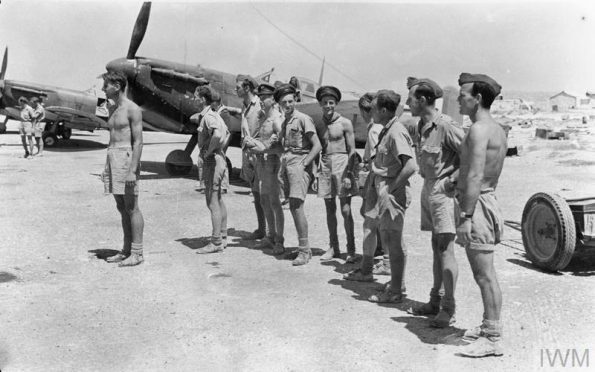Fergus Davidson was one of the many north-east heroes who made sacrifices for their country throughout World War 2.
And now, an Italian aeronautical engineer, Salvo Fagone, has discovered personal items from the cabin of Mr Davidson’s Spitfire aircraft which crashed in Sicily in 1943.
The young Aberdonian, who joined the police after the conflict and became an inspector in the traffic department of the former Grampian force, was among those who signed up with a cavalry regiment, the Scottish Horse in 1939, before advancing to horsepower of a different variety as part of 229 Squadron in Malta.
He was involved in several missions to protect the island from enemy attack and, on June 13, 1943, took off to escort USA Liberator bombers on a journey from Malta to Catania in Sicily.
But his Spitfire was intercepted by a German Luftwaffe pilot, Herbert Rollwage, on board a Messerschmitt and the Scot was shot down near Mineo on the Italian island. He managed to bail out, but his vehicle was destroyed.
However, Mr Fagone, 39, told the Press and Journal how he had found parts of the destroyed craft, along with some of the pilot’s personal service memorabilia, while participating in another search at the end of last year.
The father-of-two said: “I was involved in research into American pilot, Lt Allan Knepper, who has been missing in action since WW2.
“But while working in Palagonia, which is about 12 kilometres from Mineo, I unearthed parts of Mr Davidson’s craft which form part of the cabin of his aircraft. They are iron and metal and have personal significance.
“It has obviously been a long time since this happened, but I want to contact the Davidson family, because I think what I have found could be very important for them and their family history.”
Mr Davidson died in February, 2011, at the age of 90, and his wife, Margaret, is also deceased.
But he previously wrote his autobiography “From One to One Thousand Horsepower: How a Scottish Cavalryman became a WW2 Fighter Pilot”, which chronicled his far-flung wartime experiences.
And one of his former colleagues, Tony Fraser, who works with the Retired Police Officers’ Association Scotland in the north east, spoke yesterday about his memories of the man he called Ted.
He said: “I used to visit Ted and I got a set of cushions made up for him, depicting Spitfires in combat with German bombers. He liked these and gave me a spinning reel he had made on a lathe. He was very skilled in metalwork.
“His RAF service was up there with the best and his was an incredible story, and his book is a must-read. It’s good, even at this stage, to learn that items from his Spitfire have been discovered.
“He went from riding horses to flying Hurricanes and he was involved with the RAF, both in Britain and in Europe, whether embarking on night flights or taking part in reconnaisance missions.”
Since the spring of 2015, Mr Fagone has been scouring the south-east of Sicily for unreported or undocumented crash sites, dating back to the summer of 1943.
He and his colleagues have unearthed a number of crash sites and amassed an impressive amount of metallic artefacts, which have been returned to a number of American servicemen.
Now, he is keen to reunite the Davidson family with his most recent findings.
The personal story of Fergus Davidson
Fergus Davidson enlisted at the outbreak of war in 1939 and signed on with cavalry regiment, the Scottish Horse, in which he served until the opportunity presented itself for him to volunteer for a transfer to the RAF.
He was soon training to become a pilot and, after earning his wings, was posted to 534 Squadron at RAF Tangmere in Sussex where he flew a 1000-horsepower Hawker Hurricane, a very different steed from his previous one-horse-power mount.
He took part in numerous night missions from Tangmere before being transferred to 91 Squadron, at RAF Hawkinge on the Kent coast, from where he flew photoreconnaissance missions over the Channel.
Having volunteered for overseas service, in 1943 he found himself on a ship bound for Algiers and thence to Malta, where he joined 229 Squadron, equipped with Spitfires and charged with protecting the island from enemy attack.
Mr Davidson took part in many aerial escapades before his luck ran out and he was forced to bail out of his stricken aircraft over enemy territory.
He was captured, interrogated and transferred to a prisoner of war camp in Germany – the infamous Stalag Luft 6 – where he spent all but the final months of conflict.
Even as the end of the hostilities beckoned, he and his fellow POWs were confronted with a final marathon of endurance when they were force-marched hundreds of miles in atrocious winter conditions by their captors.
This was designed to prevent them being liberated by Allied forces.
Eventually, though, he returned to Aberdeen, married Margaret and the pair celebrated their golden wedding anniversary in 1999.
